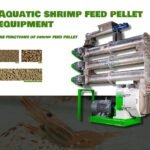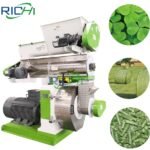Straw pellet making machines are designed to convert agricultural straw into high-density fuel pellets, and they consist of several key components that work together to ensure efficient production. Here’s an overview of the main components of a typical straw pellet making machine:
1. Feeding System
- Hopper: A large container that stores the raw straw material before processing. It ensures a steady supply of material to the machine.
- Screw Conveyor: Moves the straw from the hopper to the pelletizing chamber at a controlled rate, ensuring consistent material flow.
- Magnetic Separator: Removes metal contaminants from the straw to prevent damage to the machine and maintain pellet quality.
2. Crushing/Grinding Unit
- Hammer Mill or Crusher: Reduces the size of the straw particles to make them suitable for pelletization. This step is crucial for uniform pellet formation.
- Screen: Determines the final particle size of the crushed straw. A consistent particle size contributes to better pellet quality and durability.
Related post: https://www.pellet-richi.com/wood-pellet-machine/biomass-pellet-production-line.html
3. Mixing and Conditioning Unit
- Mixer: Blends the crushed straw with any additives or binders, if necessary. This ensures even distribution of materials and improves pellet quality.
- Conditioner: Adds moisture and heat to the straw mixture, softening the lignin and improving binding properties. Proper conditioning is key to producing strong and durable pellets.
4. Pelletizing Chamber
- Die: A metal plate with numerous small holes through which the conditioned straw is forced to form pellets. The die’s design affects the size and quality of the pellets.
- Rollers: Press the straw material against the die, applying the necessary pressure to form pellets. Rollers are critical for achieving the desired pellet density.
- Cutting Knives: Cut the extruded straw into pellets of the desired length. The knives must be sharp and properly adjusted for consistent pellet size.
5. Drive System
- Main Motor: Powers the pelletizing chamber and is typically the largest power consumer in the machine. It drives the rollers and die.
- Gearbox: Transfers and adjusts the power from the motor to the pelletizing components, allowing for proper speed and torque.
- Secondary Motors: Power auxiliary components like the feeding system and conditioner. They ensure all parts of the machine operate smoothly.
6. Cooling System
- Cooler: Usually a counter-flow cooler that uses ambient air to reduce the temperature of the hot pellets after extrusion. Cooling prevents pellet degradation and prepares them for storage.
- Fan: Circulates air through the cooler to effectively remove heat and moisture from the pellets, ensuring they reach the desired temperature and moisture content.
7. Control Panel
- PLC (Programmable Logic Controller): Manages the operation of all machine components, automating the production process for efficiency.
- HMI (Human-Machine Interface): Allows operators to monitor and adjust machine parameters. It provides a user-friendly interface for managing the machine’s functions.
- Sensors: Monitor various aspects of the process, such as temperature, pressure, and feed rate, to ensure optimal operation and product quality.
8. Dust Collection System
- Cyclone Separator: Removes fine dust particles from the air, improving air quality and reducing the risk of dust explosions.
- Dust Collector: Captures and stores the collected dust, which can be disposed of or reused, depending on the system design.
9. Lubrication System
- Oil Pump: Circulates lubricant to the moving parts of the machine, reducing friction and wear.
- Oil Filters: Keep the lubricant clean and free from contaminants, ensuring smooth operation and extending the machine’s lifespan.
10. Safety Features
- Emergency Stop Buttons: Provide a quick and easy way to shut down the machine in case of an emergency, protecting operators and equipment.
- Safety Guards: Protect operators from moving parts and reduce the risk of accidents.
- Overload Protection: Prevents damage to the machine by automatically shutting down or reducing power in case of excessive load.
Conclusion
Understanding the main components of a straw pellet making machine is crucial for efficient operation, maintenance, and troubleshooting. Each component plays a specific role in the pellet production process, from feeding the raw material to producing and cooling the final pellets. By ensuring that each part is functioning correctly and maintained properly, operators can achieve high-quality pellets and a smooth, productive manufacturing process.
As technology advances, straw pellet making machines are becoming more efficient and sophisticated, incorporating smart technologies and automation to enhance performance and reduce operational costs. Staying informed about these developments will help operators and investors make better decisions and optimize their pellet production operations.


